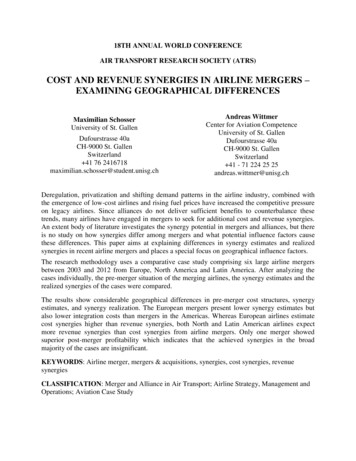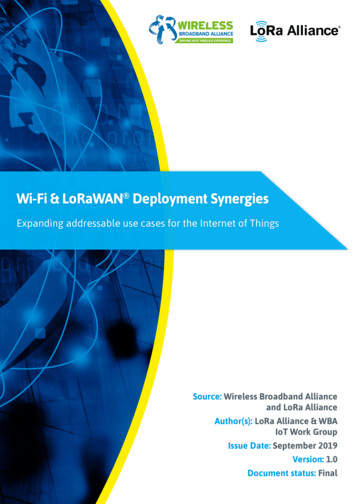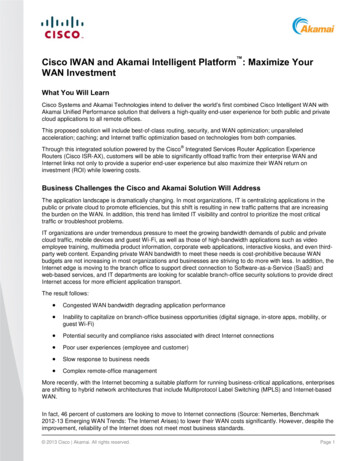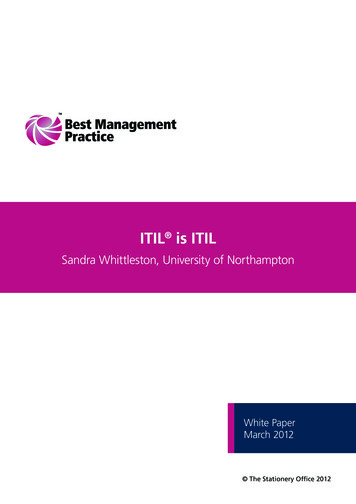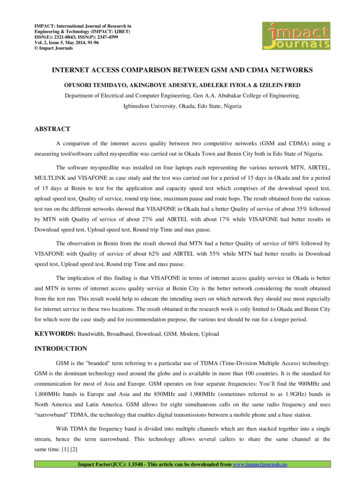
Transcription
Maximize the synergies betweenITIL and DevOpsAnthony OrrAXELOS.comWhite PaperAugust 2014
ContentsExecutive Summary 3Introduction 3ITIL Architecture 5Adopting DevOps 12ITIL and DevOps - A Powerful Combination13Conclusion 13Abouth the author 14About BMC 14About AXELOS 14Acknowledgements 15Trade marks and statements15
Maximize the synergiesbetween ITIL and DevOps1Executive SummaryThis white paper describes the synergies between ITIL best practices and DevOps (developmentand operations) practices. ITIL focuses on the lifecycle of services, from inception to retirement, andprovides best-practice guidance for IT service management (ITSM). The ITIL service lifecycle includesthe development and operation of services. DevOps is a movement, inspired by lean methodology andagile development practices, which aims to achieve seamless workflow for product synchronizationbetween all possible organizational functions – especially development and operations groups. A DevOpsapproach tries to reconcile the different priorities and processes of these groups, all for the purpose offacilitating greater business agility and delivering more value to the end user. In some organizations, thiswork is performed by virtual teams from different groups. ITIL describes rapid application developmentin the service design book as using agile software development.Most IT organizations are struggling to remove silos that hamper their ability to work collaboratively.Failure to collaborate interferes with the effective use of an organization’s capabilities and resources,leading to inflexibility and inefficiency in the delivery and support of services. When that happens, thereputation of IT can suffer. Most companies – also not-for-profit organizations – are entirely dependenton the internet for their core businesses and the speed to innovation there is staggering. That means theability of a business to react to market dynamics is based to a large degree on the agility and flexibilityof their IT department.Since so many organizations rely on ITIL as the foundation of their service management processes,understanding the synergies between ITIL and DevOps is essential to improving organizationalperformance and business outcomes. As many recent examples have shown, IT organizations that fail toconfront and reconcile the widening gap between their development and operations teams stand to losetheir footing in today’s competitive business environment.2IntroductionTo get a complete perspective of the depth of best practices that ITIL addresses, organizations shouldunderstand the key frameworks and standards that apply to ITSM. These include, for example, thefollowing: ITIL, ISO/IEC 20000, ISO/IEC 27001, CMMI , COBIT , PRINCE2 , PMBOK , M o R ,eSCM-SP , eTOM and Six Sigma . For best-practice guidance, DevOps processes can turn to ITIL asthe foundation architecture, referencing other standards and frameworks as needed to solve particularbusiness issues.These proven practices also can be combined with organizational-specific practices for competitiveadvantages and improvement of the practices themselves. ITIL, because it is a non-proprietaryand non-prescriptive approach, helps with the construction of enterprise-specific frameworks. ITILguidance enables you to modify your own processes and address the DevOps gaps based on IT servicemanagement best practices. (See Figure 1.)3
4Maximize the synergiesbetween ITIL and DevOpsFigure 1 Source of best practiesITIL describes the application management process in the service operation publication as havingthe following activities – requirements, design, build, deploy, operate and optimize (Figure 2). ITILis interested in the overall management of applications within the application management function.Alignment between development and operations of the applications needs to be accomplished.Applications development should be involved in all stages of the ITIL service lifecycle at various levelsof engagement. The ITIL application management lifecycle does not replace any software developmentlifecycle but is meant to show collaboration between application management and operationmanagement.Figure 2 Application management cycle
Maximize the synergiesbetween ITIL and DevOpsIt is important to remember the ITIL service lifecycle stages are dynamic. This dynamic nature can beapplied for decision support. For example, although you may be focused on one stage of the lifecyclein your job function, you may have to make decisions related to another stage – such as a developerworking with the release and deployment process in service transition having to make service designdecisions before building the release. The requirements stage is active during service design stage of thelifecycle. The design stage translates requirements into specifications for the application, environmentand operational model. In the build stage the application is coded or acquired; and with the operationalmodel are made ready for deployment. Build and deploy are a part of the release and deploymentprocess in the service transition stage of the lifecycle. Release includes build and test; deploymentincludes installation and training for the application. Early life support (ELS) helps with deployment tooperation success. When the service or application is in operation value can be realized and the servicecan be monitored for continual improvement of optimization. The key performance indicators (KPIs)tained including user satisfaction can direct further development improvements and provide a DevOpspractice with factual information for development and operation coordination and collaboration.DevOps uses agile and lean methodologies to improve or expedite solutions through development tooperations stages for value realization. Agile methods depend on interactions and collaboration amongpeople, processes and technology. The specific process areas of configuration management, changemanagement and release and deployment are very important in an agile environment. Just as in ITIL,the process integrations help foster agility. The success of agile methods (particularly when addressingthe DevOps gap), while sometimes measured by the increased volume of deliveries, is best measured bycustomer satisfaction, given the continual delivery of needed solution and services.Continual delivery of developed service solutions needs to be in synchronization with the ability of theconsumer to absorb the benefit. Services that are delivered too slowly cannot meet the needs of theconsumer and services delivered too fast cannot be utilized. Service solutions should also leverage theconsumer’s service value chain and be continuously integrated to avoid the necessity for the creation ofmanual procedures where once automation existed.A DevOps strategy that facilitates aforementioned continual delivery and continuous integration shouldleverage technology that has integrated and automated application-release capabilities. This technologyshould provide the following major capabilities based on ITIL best practices:a real-time, end-to-end, actionable view with comprehensive visibility of releases as they progressthrough their individual processescontrol over environment configurations to eliminate inconsistencies, unauthorized changes andmisconfigurationsintegration of automation and human-oriented workflowsdiagnostics and root-cause analysisseamless integration with change management to track changes during a release.3ITIL ArchitectureFigure 3 Simple ITIL foundation architecture5
6Maximize the synergiesbetween ITIL and DevOpsThis section reviews ITIL architecture and how it applies to DevOps. ITIL consists of five servicelifecycle stages, and key processes described in five core publications (see Figures 3,4 and 5):service strategyservice designservice transitionservice operationcontinual service improvement.Continual service improvement is integral in all other lifecycle phases, each stage of the lifecycle isdynamic and supports the other stages. ITIL focuses on utilizing people, processes, products andpartners for the effective, efficient, and economic delivery and support of services. Each publicationfocuses on particular process areas to support the decisions that must be made within that stage ofthe service lifecycle. The entire service lifecycle is relevant for DevOps because it focuses on servicedelivery and defining the overall service relationship between the customer and supplier.Figure 4 ITIL service lifecycle approachFigure 5 ITIL service lifecycle processes
Maximize the synergiesbetween ITIL and DevOps3.1 SERVICE STRATEGYThe definition of service management is “a set of specialized organizational capabilities for providingvalue to customers in the form of services”. Services are supported by service assets which areorganizational capabilities and resources. Suppliers and customers have service assets. The relationshipbetween the customer and the supplier is defined how the service asset work in an exchange fashion todeliver the service. For example, a customer has an asset such as a person that needs to use a supplierIT infrastructure asset. Figure 6, illustrates that the practice of service management is simply to provideservice assets to customers and to eliminate any constraints in the use of the service for maximumperformance to support business outcomes. DevOps, in this case, becomes an enabler for increasing thematurity of the service management practice within a supplier’s organization by removing constraints toservice delivery performance and can be thought of as an organizational strategy for this purpose.Figure 6 ITIL service lifecycle approachThe service structures in the value network play a key role in service management and the stages oforganizational development. IT service management is actually a value network within an organizationand has patterns of collaborative exchanges. This exchange of information in an agile, collaborativemanner between development and operations is in line with the spirit of DevOps.The stages of organizational development are: network, direction, delegation, coordination andcollaboration – and they are related to a management style. Network organizations, for example, oftenhave no specific structure, specific governance or defined processes. Collaborative groups, at the otherend of the spectrum, have service governance and many defined processes and are highly skilled inteamwork. DevOps functions best in a collaborative structure because of the increased responsiveness tochanging customer needs.All the stages of the ITIL service lifecycle must support the service strategy. Activities, resources andcapabilities needed for DevOps must support the overall business strategy. For example, if you developany application, a DevOps approach supports service performance and the way you go to market withthe services that you deliver. This helps the organization run the business better by becoming moreefficient and effective with usage of service resources focused on providing value to the end consumer.This can also help the organization grow their business in the markets that they serve or new marketsbecause of the cost savings from the efficiencies gained which can be reinvested into new services. Thekey DevOps concept that supports this is the improvement in the relationship between development andoperations.13.2 SERVICE DESIGNITIL positions the application management development function within operations as a function thatworks across the service lifecycle, collaborating with other functions throughout the process – which isvery much in the spirit of DevOps. For example, in service design, this collaboration involves helping withbuild-or-buy decisions. If the decision is to build the solution, the service assets (including people) mustwork collaboratively as members of the service design team to coordinate efforts and produce a servicedesign plan (SDP) or service requirements plan. The SDP describes application-related outcomes and the7
8Maximize the synergiesbetween ITIL and DevOpsbusiness relevance as well as the underpinning activities and capabilities needed.The SDP can become a critical document for decision support with DevOps activities because itbasically describes the scope of the developed application. Not setting user application capabilityexpectations can result in incidents related to non-features of the application resulting in reactivedevelopment efforts with little or no supplier value. These requests should be treated as requests toinspire strategic thinking on the overall value of request to customer and supplier, appropriate costmodel for financial recovery, development strategy and many other concerns for overall value creationand realization. DevOps practices enforce working in a service oriented fashion instead of a misguidedreactive siloed fashion, ITIL as a foundation can help with this focus.3.3 SERVICE TRANSITIONService transition enables a key capability needed within a DevOps environment: collaboration. Theprimary purpose of service transition is risk management and knowledge management. The specificprocess areas that enable service transition are transition planning and support, change management,knowledge management, asset and configuration management, change evaluation, service validationand testing. Service transition supports the service strategy organizational structure and developmentphases. Also crucial to service transition is building the appropriate service to support businessoutcomes. Development should ensure that any application updates delivered will provide value to thebusiness customer and the service provider. (See the ITIL publications for more information about valuecreation and value realization.)Application management works with the service transition release and deployment process areas tobuild, test and implement the new service and to be available for early life support (ELS), helping ITachieve expectations and reduce incidents related to the service. The overall planning and coordinationof services is accomplished through transition planning and support, configuration, change, release anddeployment management.Service transition can be reactive or proactive. Reactive service transition can implement a change toprevent an immediate risk. Proactive service transition focuses more on trends and future businessneeds. Both are relevant in a DevOps environment. Understanding the relationship of service transitionpolicies and processes to reactive and proactive behavior can enhance service agility and DevOps. Beingproactive is helpful but usually not enough, since proactive behavior can still impact quality of service,the service experience and service relationship. Sometimes IT organizations adopt a DevOps approachbecause they need to improve overall customer satisfaction. IT must also ensure that the organizationis service focused to mitigate service risk. The next step in maturity for an organization that adopts aDevOps approach and ITIL is to focus on service alignment.In the service transition stage, application management and operations management meet. Servicetransition best practices help enable agility and, therefore, help enable DevOps as a practice. Thepractice of DevOps supports the organizations overall practice of ITSM. Organizational maturity,especially as it relates to people roles and responsibilities in service transition is the organizationalchallenge that must be met for DevOps to become a reality for improved value.3.4 SERVICE OPERATIONA key principle in ITIL service operations is managing stability versus responsiveness. Operations wantstability; development wants to be responsive to customer needs. Business and IT requirements areconstantly changing, requiring agility in producing application functionality while at the same timemaintaining IT stability for application performance. ITIL’s service lifecycle approach helps organizationsagree to desired changes, take advantage of the existing infrastructure and understand what it takes todeliver the changes for value realization in operations.Service operation process areas can provide valuable input into DevOps. When events, incidents,problems, requests and system access tickets are created, as well as the key performance indicatorscreated, these processes can give direction to further continuous service improvement for DevOps.Integration of service operation and DevOps can help improve overall customer satisfaction and serviceusability. Service automation of these ITIL process areas coordinated with DevOps, especially event andincident management, will help improve overall service delivery performance.
Maximize the synergiesbetween ITIL and DevOpsIT organizations sometimes need to transform their services and applications quickly to meet customers’needs or risk becoming optional and having more services outsourced. Adopting a DevOps approach andITIL service operation best practices helps organizations be more responsive to business needs withoutaffecting operational stability. While at the same time support the organizational service strategy.3.5 CONTINUAL SERVICE IMPROVEMENTEvery approach can always be improved to increase overall performance and business value. DevOpsmethodology is intended, among other things, to apply the principles of continuous delivery andcontinuous integration to improve the performance of application development efforts. ITIL’s seven-stepimprovement process (Figure 7) can help facilitate this improvement. This process, and its relationshipto DevOps, are described as follows:Implement improvements.Implement lean and agile improvements.Improve and correct the DevOps approach.Strategy management for IT servicesService portfolio managementFinancial management for IT servicesDemand managementBusiness relationship managementDesign coordinationService catalogue managementService level managementAvailability managementCapacity managementIT service continuity managementInformation security managementSupplier managementTransition planning and supportChange managementService asset and configuration managementRelease and deployment managementService validation and testingChange evaluationKnowledge managementEvent managementIncident managementRequest fulfilmentProblem managementAccess managementSeven-Step Improvement ProcessIdentify the strategy for improvement.– A DevOps approach should support a business outcome.– Strategy as well as tactical and operations goals need to be understood.9
10Maximize the synergiesbetween ITIL and DevOpsDefine what you will measure.– Conduct a gap analysis for achieving DevOps integration with ITSM.– An example key measurement in DevOps could be the following: customer satisfaction and enduser performance as related to number, quality and frequency of releases.– Critical success factors (CSF) and key performance indicators (KPI) must be defined forDevOps.Gather the data.– DevOps should focus on gathering data from service transition and service operation.Process the data.– DevOps CSF and KPI data are processed and turned into information.Analyze the data.– Understand trends.– Transform information into knowledge for decision support to realize improvement.– Understand user and supplier perspectives.Present and use the data.– Understand the business improvements of implementing a DevOps approach.– Create plan for improvement.Implement improvements.Implement lean and agile improvements.Improve and correct the DevOps approach.End NotesThe ITIL glossary defines “value network” as “a complex set of relationships between two or moregroups or organizations. Value is generated through exchange of knowledge, information, goods orservices”. ITIL Glossary and Abbreviations: English (London: AXELOS, 2011), ities/ITILGlossaries 2.aspx1
Maximize the synergi
This white paper describes the synergies between ITIL best practices and DevOps (development and operations) practices. ITIL focuses on the lifecycle of services, from inception to retirement, and provides best-practice guidance for IT service management (ITSM). The ITIL service life
